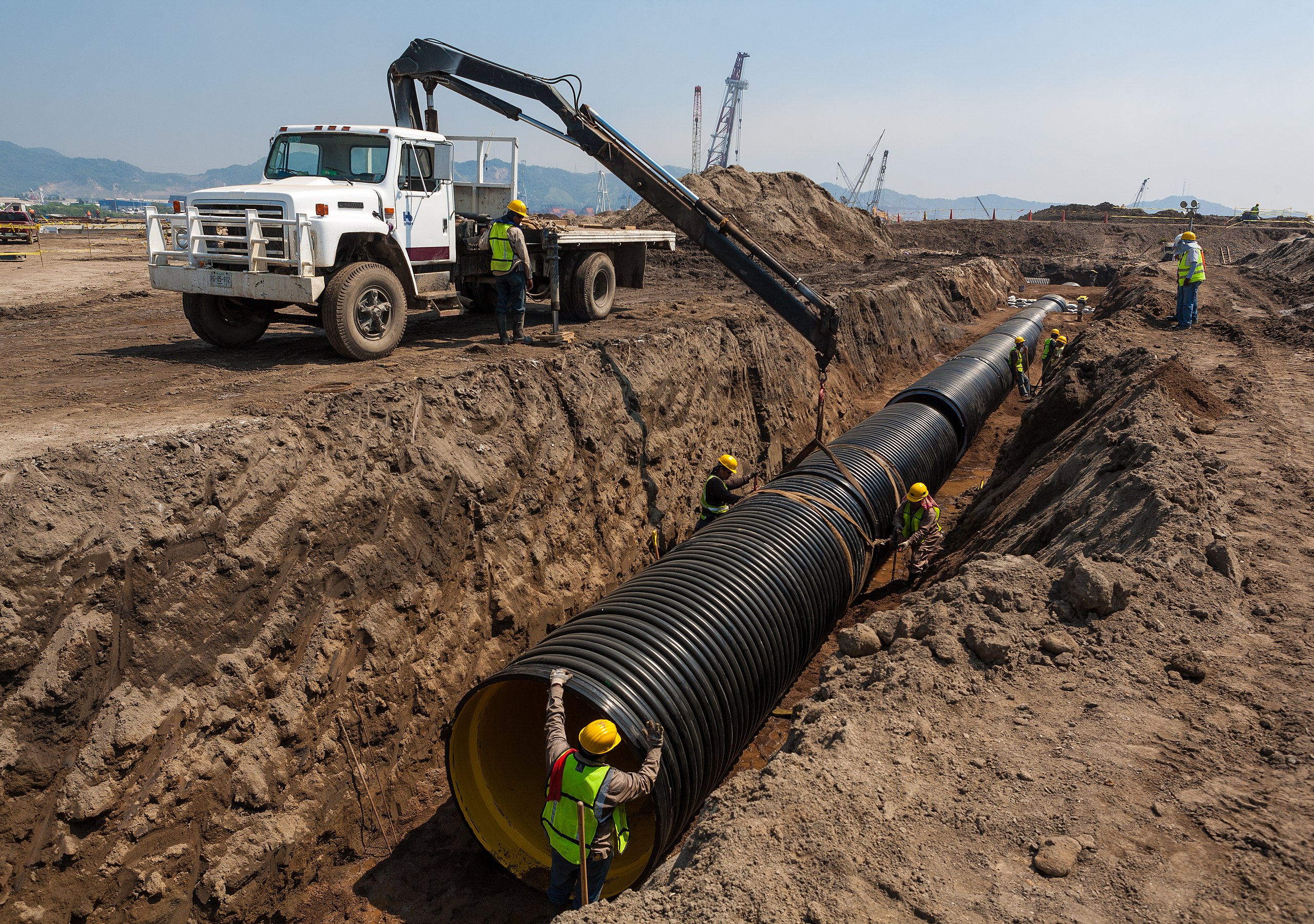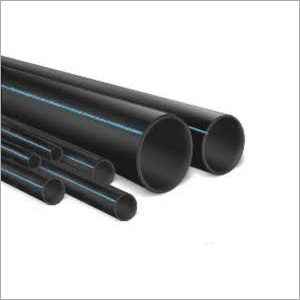How American Plastics HDPE Pipe Manufacturing Maintains Product Consistency
Discover the Manufacturing Refine Behind High-Quality HDPE Pipeline and Its Applications
The production process of top notch HDPE pipelines is elaborate and methodical. It begins with the option of raw products that boost efficiency. Following this, ethylene undertakes polymerization to develop material, which is then shaped through extrusion. Quality assurance is critical, ensuring that the end product fulfills rigorous standards. However, the trip of HDPE pipelines does not finish with manufacturing. Their applications across different industries reveal a broader importance worth analyzing.
Recognizing HDPE: Residences and Advantages

High-density polyethylene (HDPE) is a versatile polycarbonate known for its toughness and resistance to different environmental aspects. This product displays exceptional tensile strength, making it ideal for demanding applications. Its low-density structure adds to a light-weight item, assisting in convenience of taking care of and installment. HDPE also showcases impressive resistance to chemicals, which minimizes deterioration when exposed to severe materials.
The material's low moisture absorption better enhances its durability, making it optimal for usage in pipes and storage tanks. Additionally, HDPE is resistant to ultraviolet (UV) radiation, making certain that items keep their stability even when subjected to sunlight. Its flexibility enables for the development of intricate forms without endangering strength. The eco-friendly nature of HDPE, usually originated from recycled materials, includes to its charm, advertising lasting techniques in manufacturing. Overall, these homes and benefits make HDPE a preferred selection for various industrial and customer applications.
Basic Material Choice for HDPE Production
The selection of raw products for HDPE production is necessary to confirm the end product fulfills the desired requirements and high quality standards. High-density polyethylene (HDPE) is primarily generated from polymerized ethylene, acquired from nonrenewable fuel sources such as all-natural gas or petroleum. The high quality of these feedstocks substantially affects the mechanical and thermal buildings of the last HDPE.
Ingredients additionally play a significant role in boosting HDPE's efficiency, consisting of anti-oxidants, UV stabilizers, and colorants, which boost toughness and resistance to environmental elements. The choice process need to consider not only the chemical composition of the raw products yet also their handling characteristics to assure effective production.
The sourcing of raw products need to focus on sustainability and conformity with environmental policies, as liable techniques are essential in today's market. Ultimately, careful resources selection lays the structure for producing high-grade HDPE pipelines appropriate for diverse applications.
The Extrusion Refine: Shaping HDPE Pipe
The extrusion process plays a crucial function in forming HDPE pipelines, beginning with meticulous material preparation strategies that assure suitable circulation and consistency. Just as essential is the layout of the die, which directly affects the last measurements and surface top quality of the pipe. Together, these variables contribute considerably to the effectiveness and high quality of HDPE pipe manufacturing.
Material Prep Work Strategies
Reliable production of HDPE pipelines begins with precise product prep work techniques, especially the extrusion procedure. During this stage, high-density polyethylene material is initial dried out to get rid of moisture, ensuring excellent circulation attributes. The resin is after that fed right into the extruder, where it undergoes home heating and melting, changing right into a thick state. This heating process is carefully regulated to keep the product's integrity and efficiency. The molten HDPE is required through a die, forming it into a continuous pipe type. Appropriate temperature level administration throughout extrusion is crucial, as it straight influences the material's homes and the last item quality. As soon as formed, the HDPE pipeline is cooled and reduced to specified lengths, ready for succeeding handling and applications.
Die Style Relevance
Precision in die design plays a vital duty in the extrusion process of HDPE pipes. The die acts as the final shaping tool, directly affecting the pipe's measurements, wall thickness, and surface area coating. A well-designed die guarantees consistent material circulation, minimizing defects such as abnormalities and vulnerable points. The geometry of the die have to be maximized to accommodate the details residential properties of HDPE, including its thickness and thermal habits throughout extrusion. In addition, the cooling price of the product as it travels through the die can considerably influence the pipe's architectural stability. As a result, investing in innovative die modern technology is vital for manufacturers intending to generate premium HDPE pipes that meet sector criteria and customer expectations.
Quality Assurance Measures in HDPE Production
Although various factors influence the quality of HDPE pipeline manufacturing, efficient quality assurance steps are crucial to assure uniformity and reliability in the end product. Secret high quality control techniques include strenuous material evaluation, verifying that the raw polyethylene satisfies well-known standards for pureness and density. During the extrusion procedure, specifications such as temperature, stress, and cooling time are carefully monitored to keep dimensional precision and architectural integrity
Furthermore, post-production testing is important; producers usually perform hydrostatic examinations to analyze the pipeline's strength and resistance to stress. Aesthetic inspections for surface problems further enhance quality over here guarantee. Qualification from relevant standards organizations, like ASTM or ISO, supplies an added layer of trustworthiness. By implementing these comprehensive top quality control procedures, producers can reduce issues, boost performance, and make certain that the HDPE pipelines meet the particular demands of different applications, ultimately bring about consumer fulfillment and rely on the product.
Applications of HDPE Pipe Across Industries
HDPE pipelines are used across various sectors due to their resilience and versatility. In water circulation systems, they ensure effective shipment, while in wastewater management, they supply reputable remedies for waste transport. In addition, agricultural watering networks take advantage of HDPE's resistance to deterioration and adaptability, making it an excellent selection for modern-day farming methods.

Water Distribution Solutions
A substantial variety of sectors rely upon high-density polyethylene (HDPE) pipes for reliable water circulation systems. Recognized for their toughness and resistance to corrosion, HDPE pipelines are extensively used in local water system networks, farming watering, and commercial applications. Their light-weight nature promotes very easy handling and installment, reducing labor costs and time. In addition, HDPE pipes can fit different stress levels, making them ideal for both reduced and high-pressure systems. custom hdpe pipe manufacturing Midland TX. The flexibility of the material enables smooth combination into existing facilities, lessening the need for substantial excavation. HDPE's resistance to chemical seeping warranties that the water provided continues to be risk-free and clean, making it an excellent choice for preserving the high quality of potable water throughout numerous fields.
Wastewater Monitoring Solutions
Reliable water distribution systems also lead the method for ingenious wastewater monitoring remedies, where high-density polyethylene (HDPE) pipes play a considerable duty. Distinguished for their longevity and resistance to deterioration, HDPE pipes are suitable for delivering wastewater in different setups. Their adaptability enables very easy installment in complicated settings, decreasing the demand for substantial excavation. Furthermore, HDPE's smooth indoor surface area decreases friction, enhancing flow prices and effectiveness. These pipelines are additionally immune to chemical leaching, making certain that pollutants do not compromise the surrounding atmosphere. Industries, municipalities, and therapy centers increasingly depend on HDPE pipes for their reliability and durability, making them a recommended selection for modern-day wastewater administration systems. This versatility underscores the important relevance of HDPE pipelines across various applications.
Agricultural Irrigation Networks
Agricultural watering networks benefit considerably from using high-density polyethylene (HDPE) pipes, which supply reliable and trustworthy water distribution to crops. HDPE pipes are lightweight, making them very easy to transfer and mount, while their adaptability permits various setups in varied surfaces. These pipelines show excellent resistance to deterioration, chemicals, and UV radiation, ensuring longevity in harsh agricultural atmospheres. Additionally, their smooth interior surface area decreases rubbing loss, maximizing water flow and reducing power expenses connected with pumping. The long life of HDPE pipelines, usually exceeding 50 years, contributes to lower maintenance and substitute expenditures. Farmers progressively rely on HDPE pipes to enhance watering performance and promote lasting agricultural techniques, ultimately leading to boosted plant yields and resource conservation.

Future Trends in HDPE Pipeline Technology
As the need for lasting and effective facilities expands, developments in HDPE pipeline modern technology are poised to change different markets. Emerging patterns consist of the assimilation of clever innovations, such as sensing units and IoT capabilities, which promote real-time monitoring of pipe problems, lowering upkeep costs and preventing leakages. Additionally, the growth of advanced production methods, such as 3D printing, is allowing the production of complicated, tailored pipe layouts that deal with particular project demands.
Moreover, the focus on recycling and circular economic climate practices is driving the innovation of HDPE pipes made from recycled products, boosting sustainability. Boosted jointing techniques, such as electro-fusion and mechanical installations, are also boosting setup effectiveness and integrity. Ultimately, the expanding emphasis on ecological policies is pressing producers to take on greener manufacturing processes, making certain that HDPE pipelines not only satisfy industry standards but also foster an even more lasting future for original site facilities development.
Regularly Asked Inquiries
Just How Does HDPE Compare to Various Other Plastic Products?
HDPE surpasses several other plastic products pertaining to sturdiness, chemical resistance, and versatility. Its low thickness and high tensile strength make it ideal for various applications, commonly going beyond alternatives in both efficiency and durability.
What Are the Environmental Effects of HDPE Production?
The ecological influences of HDPE production include greenhouse gas exhausts, power intake, and prospective air pollution from producing processes. Furthermore, inappropriate disposal can cause soil and water contamination, elevating problems regarding long-lasting environmental results.
Can HDPE Pipes Be Recycled?
Yes, HDPE pipelines can be recycled. Several facilities approve utilized HDPE for processing, changing it right into new products. This reusing adds to sustainability initiatives, minimizing plastic waste while saving sources and energy in the manufacturing cycle.
What Is the Life Expectancy of HDPE Pipes?

Just How Do Temperature Variations Affect HDPE Pipeline Efficiency?
Temperature variations greatly impact HDPE pipeline efficiency, influencing flexibility and stamina. High temperature levels can bring about softening, while reduced temperature levels might trigger brittleness, eventually affecting the pipeline's resilience and suitability for various applications in diverse environments.